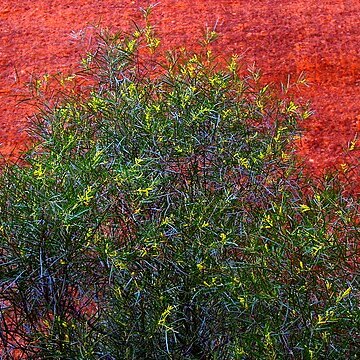Shrub or small tree to 6 (sometimes 15) m high. Bark rough, slightly fissured, grey or grey-brown. Branchlets angular or flattened towards apices, light brown to reddish, mostly glabrous. Phyllodes linear to very narrowly elliptic, flat, often curved at apex, 6–18 cm long, 2–7 (–10) mm wide, coriaceous, with margins sometimes reddish, golden-pubescent when young, soon becoming glabrous, with 1 prominent central vein; minor parallel veins 6–11 per mm, nonanastomosing; gland 1, basal, inconspicuous, to 5 mm above pulvinus. Spikes 1.5–4 cm long, densely flowered, bright or golden yellow. Flowers 5-merous; calyx 0.5–1 mm long, dissected to at least ⅘, spathulate, densely villous; corolla 1.25–1.75 mm long, dissected to ⅖–½, glabrous; ovary glabrous or tomentose towards apex. Pods linear, straight to slightly curved, 3.5–10 cm long, mostly 3–5 mm wide, chartaceous to coriaceous, glabrescent; margins vein-like. Seeds longitudinal to slightly oblique, broadly oblong to broadly elliptic, dorso-ventrally flattened, 3.1–5 mm long, dark brown; areole small, pale.
More
A tall shrub or tree. It grows 3-15 m high. The bark is flaky and grey brown. The small branches are red with a white pattern. The leaves (phyllodes) are 6-15 cm long by 0.2-0.5 cm wide. They can be curved or straight. They are shiny and flat. They have many veins. The flower heads are like rods about 2 cm long. They are yellow and without stalks. They occur as one or two in the leaf axils. The pods are 4-7 cm long by 0.3-0.4 cm wide. They are smooth, shiny and papery.
Often grows along watercourses, in gorges, crevices on rocky ranges, on sedimentary or conglomerate rocks, sometimes on sand dunes, in shrubland and woodland.
More
Often found along watercourses, in gorges, crevices on rocky ranges, on sedimentary or conglomerate rocks, sometimes on sand dunes, in shrubland and woodland.
It grows in subtropical locations. It occurs in the ranges of central Australia. It suits dry arid conditions. It needs good drainage and a sunny position.


